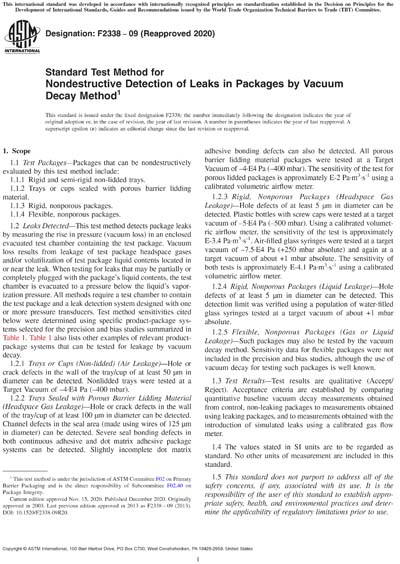Most recent
ASTM F2338-09(2020)
Standard Test Method for Nondestructive Detection of Leaks in Packages by Vacuum Decay Method
1.1 Test Packages—Packages that can be nondestructively evaluated by this test method include:
1.1.1 Rigid and semi-rigid non-lidded trays.
1.1.2 Trays or cups sealed with porous barrier lidding material.
1.1.3 Rigid, nonporous packages.
1.1.4 Flexible, nonporous packages.
1.2 Leaks Detected—This test method detects package leaks by measuring the rise in pressure (vacuum loss) in an enclosed evacuated test chamber containing the test package. Vacuum loss results from leakage of test package headspace gases and/or volatilization of test package liquid contents located in or near the leak. When testing for leaks that may be partially or completely plugged with the packageâ's liquid contents, the test chamber is evacuated to a pressure below the liquidâ's vaporization pressure. All methods require a test chamber to contain the test package and a leak detection system designed with one or more pressure transducers. Test method sensitivities cited below were determined using specific product-package systems selected for the precision and bias studies summarized in Table 1. Table 1 also lists other examples of relevant product-package systems that can be tested for leakage by vacuum decay.
1.2.1 Trays or Cups (Non-lidded) (Air Leakage)—Hole or crack defects in the wall of the tray/cup of at least 50 μm in diameter can be detected. Nonlidded trays were tested at a Target Vacuum of –4·E4 Pa (–400 mbar).
1.2.2 Trays Sealed with Porous Barrier Lidding Material (Headspace Gas Leakage)—Hole or crack defects in the wall of the tray/cup of at least 100 μm in diameter can be detected. Channel defects in the seal area (made using wires of 125 μm in diameter) can be detected. Severe seal bonding defects in both continuous adhesive and dot matrix adhesive package systems can be detected. Slightly incomplete dot matrix adhesive bonding defects can also be detected. All porous barrier lidding material packages were tested at a Target Vacuum of –4·E4 Pa (–400 mbar). The sensitivity of the test for porous lidded packages is approximately E-2 Pa·m3·s-1 using a calibrated volumetric airflow meter.
1.2.3 Rigid, Nonporous Packages (Headspace Gas Leakage)—Hole defects of at least 5 μm in diameter can be detected. Plastic bottles with screw caps were tested at a target vacuum of –5·E4 Pa (–500 mbar). Using a calibrated volumetric airflow meter, the sensitivity of the test is approximately E-3.4 Pa·m3·s-1. Air-filled glass syringes were tested at a target vacuum of –7.5·E4 Pa (+250 mbar absolute) and again at a target vacuum of about +1 mbar absolute. The sensitivity of both tests is approximately E-4.1 Pa·m3·s-1 using a calibrated volumetric airflow meter.
1.2.4 Rigid, Nonporous Packages (Liquid Leakage)—Hole defects of at least 5 μm in diameter can be detected. This detection limit was verified using a population of water-filled glass syringes tested at a target vacuum of about +1 mbar absolute.
1.2.5 Flexible, Nonporous Packages (Gas or Liquid Leakage)—Such packages may also be tested by the vacuum decay method. Sensitivity data for flexible packages were not included in the precision and bias studies, although the use of vacuum decay for testing such packages is well known.
1.3 Test Results—Test results are qualitative (Accept/Reject). Acceptance criteria are established by comparing quantitative baseline vacuum decay measurements obtained from control, non-leaking packages to measurements obtained using leaking packages, and to measurements obtained with the introduction of simulated leaks using a calibrated gas flow meter.
1.4 The values stated in SI units are to be regarded as standard. No other units of measurement are included in this standard.
1.5 This standard does not purport to address all of the safety concerns, if any, associated with its use. It is the responsibility of the user of this standard to establish appropriate safety, health, and environmental practices and determine the applicability of regulatory limitations prior to use.
1.6 This international standard was developed in accordance with internationally recognized principles on standardization established in the Decision on Principles for the Development of International Standards, Guides and Recommendations issued by the World Trade Organization Technical Barriers to Trade (TBT) Committee.
Content Provider
ASTM International [astm]






